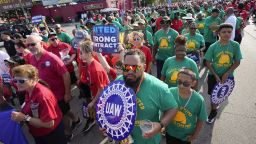Editor’s Note: Kate Bahn is an economist and the research director at WorkRise, a research-to-action network hosted by the Urban Institute. She was previously a member of ACT-UAW Local 7902 while part-time faculty at the New School for Social Research in the spring of 2023. The views expressed in this commentary belong to the author. View more opinion at CNN.
Even the United Auto Workers (UAW) president acknowledged the union’s demands are audacious: In contract negotiations between the so-called “Big Three” automakers of General Motors, Ford and Stellantis (the owner of Chrysler, Dodge and Peugeot) the UAW is demanding that their members receive the same pay for a 32-hour work week that they once did for 40. This will automatically raise worker earnings by at least 20%, likely increase the number of workers employed at auto manufacturing plants and cut into oversized and inefficient corporate profits.

While a lot of the attention has been on the political calculus of such a move at the tail end of “hot labor summer,” I’m focused on what this all means for our economy in the long-run. Viewed through that lens, this simple yet significant policy change has the potential to pump the breaks on decades of increasing income inequality and a declining labor share of income, which measures how much of our economic activity, or national income, goes to workers. And curbing those trends makes good economic sense — with benefits that extend beyond the autoworkers.
How? Consider that Americans are outliers among advanced economies in how many hours we work. Yet higher work hours don’t translate into better earnings for the average worker. The US is also an outlier in income inequality compared to other advanced economies. Moreover, the manufacturing sector in the US works on average more hours than almost every other industry. These forces result in the phenomenon of a growing gap between worker productivity and their compensation.
These trends reflect a larger troubling development in the US economy: the declining labor share of income. While economic theory recognizes that workers create all value since their work is required to produce all goods or provide services, the income generated from economic activity is split between labor and capital, which takes the form of interest, profits, dividends and realized capital gains to business owners. Economists debate the causes of the declining labor share, and while factors like global trade and technological change likely play some role, a common and probable culprit is the dual rise of corporate power and decline of worker power. These factors have contributed to the extreme rise in corporate profits.
And to be clear, outsized corporate profits are economically wasteful, since money in the pockets of shareholders generates less economic activity and does less to improve social welfare compared to money in the pockets of workers. In Econ 101, we learn that profits should be zero in the long-run, because if profits were higher than that, capital and investment would flood to that sector and competition would drive down market prices. Some minimal levels of profit may be the “wages of capital,” or what capital should earn to make up for investment, but that is nothing like what we’ve seen in recent years.
Profits at the Big Three have almost doubled in the last 10 years, according to the Economic Policy Institute. Persistent high profits like this are evidence that markets are not functioning well, so we aren’t producing as much as possible with the resources we have available.
The declining labor share and the diminishing of worker bargaining power have been the underlying factors that have allowed businesses to set poor job quality standards like erratic schedules or pay so low that workers need to have long hours to make ends meet in recent decades. One way to reverse this trend is to move to a four-day workweek while keeping the same earnings, as the UAW members have demanded, which will automatically improve job quality.
Now, it is no coincidence that this move comes at a moment where labor market conditions have become better for workers in the early economic recovery from the pandemic. But the recent positive outcomes for workers primarily resulted from changing jobs, a trend which has already begun tempering. A few years of increased churn in the labor market by itself is not enough to reverse the broader macroeconomic trends that have contributed to the long-term decline in job quality for many workers, manufacturing workers included.
But when workers are successful in bargaining for institutionalized policies like a shorter workweek, then more of the population can begin to share the benefits of a strong economy as the labor share of income tilts back toward workers. And, in doing so, workers take a step to reverse the root problem of declining worker power.





